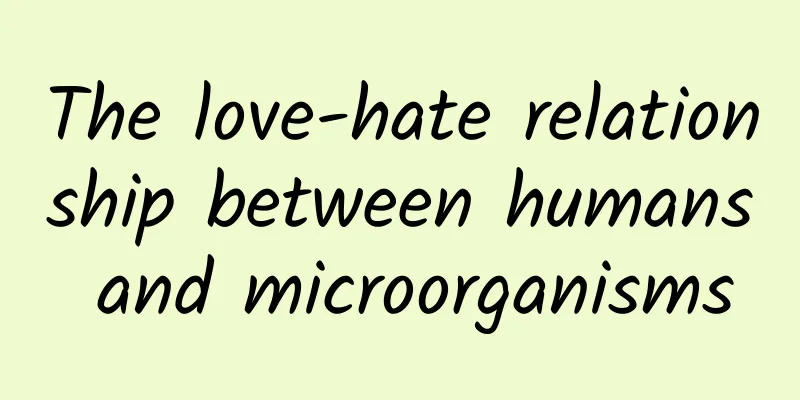The love-hate relationship between humans and microorganisms

|
Author: Zhang Zhetao, The First Affiliated Hospital of University of Science and Technology of China (Southern District) Shi Tianlu The First Affiliated Hospital of University of Science and Technology of China (South District) Guo Yujin Jining First People's Hospital Reviewer: Zhao Jie, Chairman of the Chinese Medical Association Clinical Pharmacy Branch, The First Affiliated Hospital of Zhengzhou University Chief Pharmacist Professor When it comes to microorganisms, you may ask: What are microorganisms? Where do microorganisms live? Microorganisms are a group of tiny organisms that exist in the human body and nature. They are small in size, simple in structure, invisible to the naked eye, and can only be observed with the help of a microscope. They include bacteria, viruses, fungi, chlamydia, mycoplasma, etc. that we often mention in our daily lives. Figure 1 Copyright image, no permission to reprint 1. The “confrontation” between humans and microorganisms The history of microorganisms is much longer than that of humans. Humans have lived with microorganisms since their birth. Microorganisms coexist with the human body. Although humans knew about their existence a long time ago, the first time they saw their "appearance" clearly was in 1676, when Leeuwenhoek saw microorganisms for the first time through a microscope he made by hand. In 1876, Koch injected anthrax bacteria into mice to kill them, verifying that anthrax was caused by bacteria, and thus proposed the "germ theory" of disease. From then on, humans began a war with bacteria through drug development and application. In 1928, Fleming accidentally discovered "penicillin" in the "natural arsenal" that can kill Staphylococcus aureus, which is the well-known penicillin. It is a metabolite derived from bacteria, so it is called an antibiotic. Since Florey achieved the industrial production of penicillin in 1944, more and more natural, semi-synthetic and synthetic antibiotics have been used for anti-infection treatment, and mankind has entered the antibiotic era. In 1935, Domagk extracted "Prontosil" (a sulfonamide drug) from clothing dyes, laying the foundation for the research and development direction of chemical synthesis of anti-infective drugs. Antibiotics extracted from bacterial metabolism and chemically synthesized drugs are collectively referred to as antibacterial drugs. Antimicrobial drugs, that is, anti-infective drugs, refer to drugs that can kill or inhibit the growth or reproduction of microorganisms, including antibacterial drugs, antiviral drugs, anti-trichomonal drugs, and anti-mycoplasma, chlamydia, rickettsial drugs, etc., but do not include anti-parasitic drugs. After more than 30 years of research and compilation, Rosebery published "The Human Microbes" in 1962, which described in detail the common bacteria in various parts of the human body. Pasteur, a famous French microbiologist, said: "Bacteria may be beneficial to us, or even indispensable." In 2007, the "Human Microbiome Alliance" was established in Washington, USA, aiming to fully understand the information of the microbiome in the human body, and China also became one of the initiators of the "Human Microbiome Project". It is foreseeable that our understanding of these co-dependent microorganisms will deepen day by day. 2. Harmonious coexistence between humans and microorganisms Different parts of the human body have different environments, such as specific temperatures, pH values, oxygen content, and other conditions that determine the growth of specific microorganisms. For example, our stomach secretes highly acidic gastric acid, which keeps most bacteria out. Only special bacteria such as Helicobacter pylori that can tolerate acidic environments can "station" in it. In addition, the moment a newborn slides out of the mother's birth canal, he or she receives the mother's first gift - the microbiome from the mother's body, and the baby's immune system opens a window to microorganisms. Traditionally, breast milk is considered sterile, but with the development of molecular biology, people have gradually discovered that breast milk provides babies with a diverse source of bacteria. In addition, factors such as postpartum care, delivery methods, maternal diet, and maternal use of antibacterial drugs will affect the composition of breast milk flora. As we age, our relationship with the microbiome in our bodies becomes closer: we provide them with a suitable habitat and the nutrients they need to grow, and they work hard to maintain the normal operation of our bodies. They can help us release minerals such as calcium, magnesium, and zinc in food, making food easier to absorb; they can help us synthesize certain vitamins for the body to absorb, such as B vitamins and vitamin K; they can also break down lipids that we cannot digest into short-chain fatty acids, which will gather and activate a large number of anti-inflammatory cells to calm the overreacting immune system; they can even degrade certain special chemicals (such as toxins and drugs) that we take into our bodies so that they will not "make trouble." Figure 2 Copyright image, no permission to reprint 3. Microbial influence on drug effects Our microbiota helps us process the drugs in our bodies, whether we "invite" them to participate or not. There is growing evidence that the efficacy of drugs depends not only on the drug and the body, but also on the "neighbors" in the body. One in ten patients may have little effect after taking digoxin (a drug used to treat heart failure), which is caused by the differences in a type of intestinal bacteria called "Eggsonia sulfatida". Bacteria "living" in the colon can convert sulfasalazine into 5-aminosalicylic acid, thereby exerting anti-inflammatory effects. Olsalazine is also affected by the same drug. The therapeutic effect of olsalazine depends largely on the bacteria in the intestine. Only with the help of bacterial azoreductase can olsalazine be converted into therapeutic 5-aminosalicylic acid. Similarly, lactulose relies on the metabolism of intestinal bacteria to convert into lactic acid and acetic acid, thus exerting its laxative effect. Intestinal microorganisms also affect the absorption and metabolism of statins, resulting in differences in their efficacy. In addition, some traditional Chinese medicine ingredients can also be metabolized by intestinal microorganisms into corresponding absorbable active substances, such as ginsenoside Rb1 in ginseng. The effects of drugs on the human body are also affected by the microbes in the body. Clostridium difficile (an anaerobic bacterium that lives in our intestines) affects the metabolism of acetaminophen and its hepatotoxicity. The products of irinotecan inactivated by the liver can be reactivated by intestinal microbes, leading to adverse reactions such as diarrhea, weight loss, and immune system suppression. The microbiome in our body is like the residents of every building. It is different in different people. This difference comes from many factors, such as genetic genes, living environment, age, eating habits and used drugs, especially antibiotics, which have a very important impact on the microbiome in the body. 4. Antimicrobial drugs are not a panacea In fact, microorganisms and the human body are interdependent. Under normal living conditions, the types and numbers of bacteria on and inside the human body remain relatively fixed. When the human body is caught in the rain, gets cold, is injured, undergoes surgery or other invasive procedures, or suffers from other diseases that lead to low immune function, the body's resistance will decrease, and external pathogenic bacteria or bacteria colonized on the body surface will take the opportunity to invade the human body and multiply in large numbers, leading to infection. The purpose of using antimicrobial drugs is only to kill external invading pathogens or reduce the number of locally proliferating bacteria to a balance with the human immune system, rather than to kill all the bacteria in the human body. Microorganisms can survive without humans, but the human body cannot survive without certain bacteria. Figure 3 Copyright image, no permission to reprint Microorganisms have been with us for millions of years, and how to live in harmony with them remains a topic that requires long-term research by humans. |
<<: After washing your hair, should you blow-dry it immediately or let it dry naturally?
>>: Will this internet-famous asteroid really destroy the Earth?
Recommend
A tough guy DIYs a powered exoskeleton and can lift 77 kg with ease
DIY madman The Hacksmith has done something extra...
AnySDK is available across the board, allowing you to focus on development without worrying about other things
China Joy 2015 came as scheduled, and AnySDK made...
After getting the medicine prescribed at a big hospital, should the community clinic help with the injection?
Recently, there was news that an elderly man was ...
User Operation: How does paid membership increase user stickiness?
The paid membership system can not only encourage...
There is disinfectant in the air. Where does it come from? It is formed spontaneously
Hydrogen peroxide, if this name sounds unfamiliar...
App promotion: preparation before listing on app stores and other promotion channels!
After the App is developed, promoting the App nat...
Pinduoduo Operation: How to attract new customers through cash?
This article is an analysis of Pinduoduo 's c...
Why does it take an average of 8 years to diagnose this disease with an extremely high suicide rate?
【Written at the end】 42.3 % of bipolar disorder c...
Why doesn’t Apple have iPhone 2 and iPhone 9?
Recently, Apple's autumn new product launch c...
The universal formula for Xiaohongshu's popular articles
Whether a big hit is a matter of luck, but whethe...
Real physics terms: Atomic bombs have nothing to do with atoms, and hydrogen bombs have little to do with hydrogen
In scientific research, scientists create proper ...
Data analysis: How to analyze the effectiveness of activities?
Scenario restoration: A music APP offers a 7-day ...
These strange-looking "lumps" turned out to be the weights used by ancient people!
A set of bronze weights from the Yuan Dynasty, ra...
WeChat iOS version updated! Voice calls can display the other party's Moments updates
[[426417]] Recently, WeChat iOS version ushered i...
Real shots of Kia's new e-generation Forte at the Guangzhou Auto Show: Will the concept-driven Korean cars be accepted by the market?
As the international situation changes suddenly, ...









